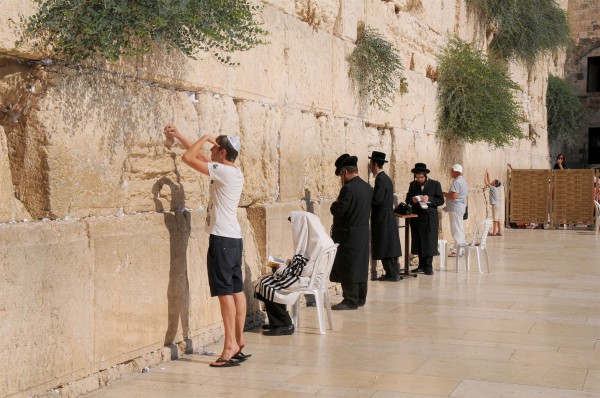Tonight as the sun sets, Jews all over the world will begin celebrating Purim, a holiday in which the heroic efforts to save the Jewish People during the time of Haman and the Persian King Achashverosh (also known as Xerxes or Ahasuerus, 486–465 BC) is retold.
This deliverance required the intervention of two Jews — Mordecai and Esther (Hadassah), whom Adonai had strategically positioned to influence the affairs of the king’s court.
Throughout the Book of Esther, the hand of God remains hidden; that is, His actions are never specified.
Because God remains veiled in the Book of Esther, and the Jewish identity of Queen Esther remains unknown to everyone except perhaps her cousin and adopted father Mordecai, one of the themes of Purim is hidden identities.
For that reason, it is traditional to celebrate this deliverance of the Jewish people from government-sanctioned genocide by dressing in costumes at Purim parties. Despite the attempted genocide under the rule of this Persian king, Purim is considered one of the most joyous and fun holidays on the Jewish calendar.
The Jewish People of Persia
Many of the Jewish captives in Babylon under Nebuchadnezzar remained in the land even after Cyrus conquered Babylon in 539 BC, placed it under the Persian Empire, allowed the Jews to return to Israel, and ordered the Temple to be rebuilt in Jerusalem at the expense of Persia.
Although they were exiled into Babylon due to sin, God did not intend for the Jewish People to perish in that foreign land, or in any land. His plans are to prosper His people.
However, the Persian Empire, which by the time of Esther stretched “from India to Ethiopia,” contained many anti-Semites who planned to rise against the Jews on the 13th of Adar.
One of those anti-Semites was Haman who devised the assassination plot and did not keep his plans a secret. He made sure that the death decree for the Jews would be known “to the people of every nationality so they would be ready for that day.” (Esther 3:13)
In a striking parallel, the leaders of Persia today (Iran) do not keep their plans a secret, either. They have conducted trial invasions of Jerusalem and published specific plans for the demise of Israel — which a top Iranian general has said is “non-negotiable.”
Likewise, modern nations and communities regularly reach out to the international community for assistance in destroying Israel. Many, especially in Gaza, seek corporate and government boycotts, sanctions, and divestment against Israeli businesses and governing bodies.
They incite violence from mosques and produce music videos that call for the murder of innocent people. Iran continues to perform missile tests and develop nuclear weapons specifically to annihilate Israel, and Hamas and Hezbollah continue to amass arms and construct tunnels for terrorist infiltration.
As we look closer at the characters of the Book of Esther, we see many more parallels and warning signs today.
Iran and Hamas: In the Footsteps of Haman and the Amalekites
Over time, the Persian Empire scaled down to the single nation of Persia, which changed its name in 1935 to Iran (from the Persian word Ērān). For a time, 100,000 Jews lived and prospered in Persia up to the 1979 revolution, which installed the Ayatollah as the supreme leader of a Shi’a Islamic Republic.
What Haman did not accomplish, the Ayatollah and Revolutionary Guards of Iran have sworn to fulfill. In this way, we see the Book of Esther as not only a historical portrait of salvation but also a prophetic voice of history repeating itself.
“It shall come to pass, when the Lord your God has given you rest from all your enemies round about, in the land which the Lord your God is giving you for an inheritance to possess it, that you shall obliterate the memory of Amalek from under the heavens. Do not forget.” (Deuteronomy 25:19)
With our eyes on current events, we remember the genocidal and petty spirit of Haman — who descended from the arch enemies of ancient Israel, the Amalekites — seeing that same spirit at work in the terrorist group and ruling entity of the Gaza Strip — Hamas.
Hamas has repeatedly fought against the Jews and, on August 18, 1988, outlined its charter calling to obliterate them.
“With regard to Israel, the charter’s stance is uncompromising. It views the ‘problem of Palestine’ as a religious-political Muslim issue, and the Israeli-Palestinian confrontation as a conflict between Islam and the ‘infidel’ Jews,” states an analysis by the Meir Amit Intelligence and Terrorism Information Center at the Center for Special Studies. “‘Palestine’ is presented as sacred Islamic land and it is strictly forbidden to give up an inch of it.”
As Haman was quick to escalate his plot to murder every Jew, Hamas intends to completely “destroy, kill and annihilate” the Jewish People and confiscate their property (Esther 3:13, Hamas Charter).
Hamas has taken the signet ring of Iran and sealed a death warrant for the Jewish people by declaring in its charter that “Israel will arise and continue to exist until Islam wipes it out, as it wiped out what went before.”
Likewise, King Achashverosh believed one man’s accusations (Haman) against the Jews and endorsed his diabolical plans to annihilate them.
This king could represent Iran today, which supports both Hamas in Gaza and Hezbollah in Lebanon, north of Israel, with weapons and funding toward their goals of annihilating Israel.
The Iranian ambassador to Lebanon, Mohammad Fathali, said on February 25 that Iran is willing to give thousands of dollars to the families of Palestinian terrorists who were killed while attacking or murdering Israelis and Jews.
While the Palestinian Authority refused, Iran’s offer amounted to $7,000 for the terrorists’ families and $30,000 if the family home were destroyed by Israel as a consequence.
“This is further proof of Iran’s deep involvement in encouraging terrorism against Israel. Following the signing of the Joint Comprehensive Plan of Action with the world powers, Iran is allowing itself to be once again a central player in global terror,” the Israel Ministry of Foreign Affairs responded in a statement.
The United Nations: In the Footsteps of the Persian Peoples
The peoples of the Persian Empire, in “over 127 provinces from India to Ethiopia” (Esther 1:1), can represent the nations of the Middle East today.
These nations have privilege and power at the United Nations, the representative body of the world, with their powerful Muslim and Arab voting blocs that favor anti-Israel dictatorships and corrupt regimes.
For instance, UN Watch Director Hillel Neuer revealed in October 2013 that “anti-democratic regimes like Communist China [heap] praise on fundamentalist Saudi Arabia, while tomorrow, as China gets reviewed, the Saudis will return the favor.”
UN Watch highlighted the problem in a March 17, 2016 post:
“SYRIA may be entering its sixth year of a civil war in which hundreds of thousands have died at the hands of the murderous Assad regime, the medieval barbarism of ISIS and the indiscriminate barrel-bombing of Putin’s warplanes, but that has not stopped the United Nations Human Rights Council from circulating a draft resolution on Israel’s ‘systematic and continuous violation’ of the rights of ‘Syrian citizens in the occupied Golan Heights.’” Also, four other draft resolutions censuring Israel will be voted on during this week of Purim.

The Megillat Esther (Scroll of Esther) is read twice on Purim, once on the Eve of Purim and once during Purim day.
Building in Jerusalem: Complaints and Accusations
“‘When seventy years are completed for Babylon, I will come to you and fulfill my good promise to bring you back to this place. For I know the plans I have for you,’ declares the LORD, ‘plans to prosper you and not to harm you, plans to give you hope and a future.’” (Jeremiah 29:10–11)
As Jeremiah prophesied, the forced exile in Babylon ended after 70 years, with the conquest of the Persian King Cyrus.
In 539 BC, the first year of the reign of King Cyrus, the LORD had moved Cyrus’ heart “to build a temple for Him at Jerusalem in Judah. ‘Any of His people among you may go up,’ Cyrus said, ‘and may the LORD their God be with them.’” (2 Chronicles 36:23)
But nothing is ever that simple. Non-Jews from Persia “bribed officials to work against them [the Jews] and frustrate their plans during the entire reign of Cyrus king of Persia and down to the reign of Darius king of Persia.” (Ezra 4:5)
Even as the Purim story was about to unfold, “at the beginning of the reign of Xerxes [Achashverosh], they [the peoples of the Persian empire] lodged an accusation against the people of Judah and Jerusalem” (Ezra 4:6) over building projects in Jerusalem.
And even after the Purim story ended, the next king, Artaxerxes, agreed with the accusations of the people, saying, “This city has a long history of revolt against kings and has been a place of rebellion and sedition. … Now issue an order to these men to stop work, so that this city will not be rebuilt until I so order.” (Ezra 4:19–21)
Like days of old, Israel today faces pressure by foreigners near and far to stop building in Jerusalem, Judea, and Samaria, to relinquish its land, and to make itself vulnerable to nations who promise annihilation.
The Watchmen of Israel: In the Footsteps of Mordecai
“If the watchman sees the sword coming and does not blow the trumpet to warn the people and the sword comes and takes someone’s life, that person’s life will be taken because of their sin, but I will hold the watchman accountable for their blood.” (Ezekiel 33:6)
Mordecai’s hidden identity is “watchman for Israel.” He was not only concerned for the Jewish people, though. He was also loyal to the Persian king, risking his own life to report a plot against the life of King Achashverosh.
This sense of duty to the welfare of the Persian leader was commanded by the Word of the Lord through the prophet Jeremiah: “Seek the peace and prosperity of the city to which I have carried you into exile. Pray to the Lord for it, because if it prospers, you too will prosper.” (Jeremiah 29:7)
Even so, as a watchman at the king’s gate, Mordecai did not bow to Haman or cower in fear at his presence (Esther 5:9), despite being pressured by the king’s officials day after day to show Haman such honor.
In the spirit of Mordecai, the Jewish People today do not bow before any foreign nation or leader. Israel exists in the land that God Himself has restored to them.
Mordecai watched for the signs of destruction to Israel and took strategic steps to seek their salvation. Esther rose up in her position and influence to partner with God and carry out His plan.
Today, in the spirit of Mordecai and Esther, we must watch for dangers posed to Israel and the Jewish People, rally for their protection, and actively participate in their salvation.

This plate for delivering Purim gifts depicts the parade honoring Mordecai, which the king had ordered to acknowledge Mordecai’s role in uncovering a threat to the king. Dressed in royal apparel, Mordecai rides a horse led by Haman. Inscription: [Hebrew] Outer rim: “Send portions one to another and gifts to the poor” (after Esther 9:22). Inner rim: “Thus shall it be done unto the man whom the king delights to honor” (Esther 6:11). (Magnes Collection of Jewish Art and Life)
Divine Providence Partners with Human Action
Mordecai saw God’s Divine Providence at work in Esther’s life, and told her, “If you remain silent at this time, relief and deliverance for the Jews will arise from another place, but you and your father’s family will perish. And who knows but that you have come to your royal position for such a time as this?” (Esther 4:14)
Though Queen of Persia, Esther risked displeasing the king and, in fact, broke the law of the land by approaching him without being called.
Similarly, those who risk their reputation or well being by advocating for the people of God and the nation of Israel illustrate the character of Queen Esther.
Esther appeared at the king’s palace and won his favor. Moreover, instead of Haman killing the Jewish people, the king executed Haman and allowed the Jewish People to kill their enemies throughout the land.
Esther didn’t accomplish this heroism alone. She called for the entire Jewish People in Persia to fast with her for three days and pray to the God of Israel for her.
Though hidden, God was with her.
Therefore, those who commit to intentional prayer and fasting, and rally others to do the same are also acting in Esther’s spirit.

Esther before Ahasuerus (photo of Dominican Priory Church of Hawkesyard in Staffordshire window by Fr. Lawrence Lew O.P.)
Eerdmans Commentary on the Bible explains God’s Divine Providence this way: “The theology of Esther appears to be that there is a divine providence which works to protect the Jews; however, this divine providence works behind the scenes and through human agency, not by direct intervention in events, and the working out of the divine plan is never transparent to its human participants.” (p. 329)
In the end, the Jewish people’s survival has always been due to the grace of the Almighty God of Israel. It will always be Him joining forces with our efforts that will bring about the salvation we seek.
Is it possible for us to replicate the faith and courage of Esther and Mordecai?
These two may be heroes, but their choices are available to each of us: turn to God in prayer and fasting, use our voices to make a difference for those who might be in desperate circumstances, and understand that maybe “you have come to your [position] for such a time as this.” (Esther 4:14)















